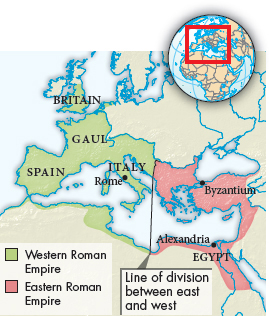Political Measures
During the crisis of the third century the Roman Empire was stunned by civil war, as different individuals, generally military commanders from the border provinces, claimed rights to leadership of the empire. Beginning in 235, emperors often ruled for only a few years or even months. Non-
Diocletian, who had risen through the ranks of the military to become emperor in 284, ended the period of chaos. Under Diocletian the princeps became dominus, “lord,” reflecting the emperor’s claim that he was “the elect of god.” To underscore the emperor’s exalted position, Diocletian and his successor, Constantine, adopted the court ceremonies and trappings of the Persian Empire.

Diocletian recognized that the empire had become too large for one man to handle and so in 293 divided it into a western and an eastern half. He assumed direct control of the eastern part, giving a colleague the rule of the western part along with the title augustus. Diocletian and his fellow augustus further delegated power by appointing two men to assist them. Each man was given the title caesar to indicate his exalted rank.
After a brief civil war following Diocletian’s death, Constantine eventually gained authority over the entire empire but ruled from the East. Here he established a new capital for the empire at Byzantium, an old Greek city on the Bosporus, a strait on the boundary between Europe and Asia. He named it “New Rome,” though it was soon called Constantinople. In addition, he built defensive works along the borders of the empire, trying hard to keep it together, as did his successors. Despite their efforts, however, the eastern and the western halves drifted apart.
The emperors ruling from Constantinople could not provide enough military assistance to repel invaders in the western half of the Roman Empire, and Roman authority there slowly disintegrated. In 476 a Germanic chieftain, Odoacer, deposed the Roman emperor in the West. This date thus marks the official end of the Roman Empire in the West, although the Roman Empire in the East, later called the Byzantine Empire, would last for nearly another thousand years.